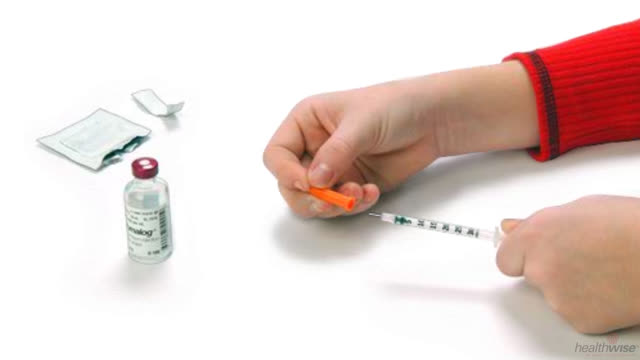Gestational Diabetes: Giving Yourself Insulin Shots
Introduction
If you have gestational diabetes and you have not been able to keep your blood sugar levels within a target range, you may need insulin shots.
- Taking insulin can help prevent high blood sugar. High blood sugar can lead to problems for you and your baby.
- Insulin is given as a shot into the fatty tissue just under the skin. In pregnant women, insulin usually is given in the upper arm or thigh.
- Make sure that you:
- Have the right dose of insulin, especially if you are giving two types of insulin in the same syringe.
- Practice how to give your shot.
- Store the insulin properly so that each dose will work well.
How to prepare and give an insulin shot
Your doctor or certified diabetes educator (CDE) will help you learn to prepare and give yourself insulin shots. Here are some simple steps to help you learn how to do it.
Get ready
To get ready to give an insulin shot, follow these steps:
- Wash your hands with soap and running water. Dry them thoroughly.
- Gather your supplies. Most people keep their supplies in a bag or kit so they can carry the supplies with them wherever they go.
- You will need an insulin syringe, your bottle of insulin, and an alcohol wipe or a cotton ball dipped in alcohol.
- If you are using an insulin pen, you will need a needle that works with your pen. If the pen is reusable, you may need an insulin cartridge. You may also need an alcohol swab.
- Check the insulin bottle or cartridge.
- When you use an insulin bottle for the first time, write the date on the bottle. Insulin stored at room temperature will last for about a month. Read and follow all instructions on the label, including how to store the insulin and how long the insulin will last.
- Check that a disposable pen’s insulin has not expired. This date is usually printed on the pen’s label.
Prepare the shot
Your preparation will depend on whether you are giving one type of insulin or mixing two types of insulin.
If you are using an insulin pen, follow the manufacturer’s instructions for attaching the needle, priming the pen, and setting the dose.
Prepare the site
Before giving your shot, take the time you need to do the following:
- Choose the part of your body to inject. If you give your shots in different places on your body each day, use the same site at the same time of day. For example, each day:
- If you use alcohol to clean the skin before you give the shot, let it dry.
- Relax your muscles in the area of the shot.
Give the shot
Follow the steps for giving an insulin shot in the arm.
Follow the steps provided by the pen manufacturer for giving an insulin injection with a reusable insulin pen.
Clean up and storage
After giving your shot:
- Store your insulin properly so that each dose will work well. Follow the instructions that come with the insulin.
- Do not throw your used syringe, disposable insulin pen, or needle in a trash can. You can dispose of it in a metal container that either has a lid that screws on or a lid that you tape down tightly. You also can buy special containers for disposing of used needles and syringes. Talk with your local trash disposal agency, pharmacy, or your doctor about how to get rid of the container.
Other suggestions for success and safety
To help you be safe and successful in giving your insulin shots:
- Teach someone else to give your insulin shots. Have that person give you a shot from time to time so they will know how to do it in case of an emergency.
- Do not mix other medicine with insulin without your doctor’s instruction. If you are taking two types of insulin, ask your doctor or pharmacist whether they can be mixed in the same syringe.
- Never share syringes with another person. Diseases, such as HIV or infection of the liver (hepatitis), can be transferred through blood.
Credits
Current as of: April 16, 2019
Author: Healthwise Staff
Medical Review:Kathleen Romito, MD – Family Medicine & Adam Husney, MD – Family Medicine & Rhonda O’Brien, MS, RD, CDE – Certified Diabetes Educator & David C. W. Lau, MD, PhD, FRCPC – Endocrinology
Current as of: April 16, 2019
Author: Healthwise Staff
Medical Review:Kathleen Romito, MD – Family Medicine & Adam Husney, MD – Family Medicine & Rhonda O’Brien, MS, RD, CDE – Certified Diabetes Educator & David C. W. Lau, MD, PhD, FRCPC – Endocrinology
 Insulin Syringes
Insulin Syringes Steps for preparing a single dose of insulin
Steps for preparing a single dose of insulin Steps for preparing a mixed dose of insulin
Steps for preparing a mixed dose of insulin Insulin Injection Areas for Gestational Diabetes
Insulin Injection Areas for Gestational Diabetes Giving an insulin injection into the arm
Giving an insulin injection into the arm Insulin: How to Prepare a Single Dose
Insulin: How to Prepare a Single Dose Insulin: How to Prepare a Mixed Dose
Insulin: How to Prepare a Mixed Dose Diabetes: Insulin’s Role
Diabetes: Insulin’s Role Insulin: Giving an Injection in the Arm Using a Syringe
Insulin: Giving an Injection in the Arm Using a Syringe How to Give a Subcutaneous Injection
How to Give a Subcutaneous Injection
